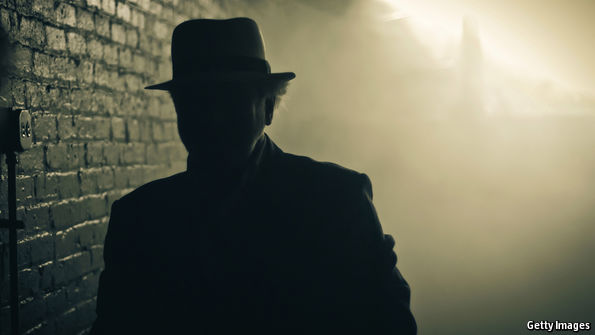
John le Carré: The Biography. By Adam Sisman. Harper; 651 pages; $28.99. Bloomsbury; £25.
JOHN LE CARRÉ’S novels study human treachery, ideological conflict and geopolitical upheaval with a rare intelligence and sympathy. Of the author himself, whose real name is David Cornwell, not much is known beyond (sometimes contradictory) snippets offered in interviews and facts masquerading as fiction in his most autobiographical novel, “A Perfect Spy” (1986). Now, Adam Sisman, the author of acclaimed biographies of A.J.P. Taylor and Hugh Trevor-Roper, has got behind Mr le Carré’s mask to unravel the enigma.
Mr Sisman makes it clear at the outset that he is an admirer and that Mr le Carré (whom he refers to throughout as “David”) wished him to write “without restraints”. What could have been a cloying hagiography or a lurid warts-and-all exposé is instead a balanced, focused and compelling study of a man of depth and individuality.
Mr le Carré’s childhood was marked by heartache and disruption. His mother left when he was five. The following “16 hugless years” consisted of a series of prep schools, bounced cheques and broken promises. Ronnie, his flamboyant con-man father, is everywhere, seemingly a lovable rogue with the gift of the gab who lived beyond his means with a variety of lady friends, executing one elaborate scam after another. Beneath the glitzy exterior was a core so tawdry at times it was downright sinister. Ronnie was in and out of prison for fraud. He beat his wife, groped his children and scammed not only strangers, but friends and relatives too. Years later, one partner in crime told Mr le Carré that his father was “very, very bent”.
Mr le Carré spent large chunks of his life appalled by Ronnie’s deeds, humiliated by his presence and haunted by his memory. At 16 he fled to Bern to immerse himself in German literature. After he returned to England and while studying at Oxford, he was approached by MI5 and given the task of infiltrating left-wing student groups to identify communists. When he was eventually recruited as a full-time spy he left MI5 (“a dead-end sort of place”) for the more glamorous MI6, the secret intelligence service (SIS), and a posting in Bonn, “a nest of spies”. To supplement his income, Mr le Carré began to write and, after two modest successes, his third novel, “The Spy Who Came in from the Cold” (1963), launched his literary career. It was written in just five weeks.
Readers got a glimpse of the real, murky world of espionage, the flip side to Ian Fleming’s glossy, soft-focus artifice, with the flawed and jaded Alec Leamas more victim than hero. Further bleakness, moral uncertainty and anti-Bond protagonists followed, in “Tinker, Tailor, Soldier, Spy” (1974), which featured Mr le Carré’s most famous creation, George Smiley. “The Secret Pilgrim” (1990) was Smiley’s swansong, appearing a year after the fall of the Berlin Wall. Some people thought that Mr le Carré had lost his subject; the spy novel was dead. Mr Sisman disagrees. “Communism might have been vanquished,” he writes, “but other enemies remained.” In his post-cold-war novels Mr le Carré has tackled Russian mafias in “Single & Single” (1999), the pharmaceutical industry in “The Constant Gardener” (2001) and even the American government in his most strident novel, “Absolute Friends” (2003).
Mr Sisman reveals the inspiration for Mr le Carré’s plots and characters, finding real examples for those perennial themes of abandonment and betrayal, and offering illuminating accounts of fact-finding field trips. However, readers hoping for pages of unlocked state secrets and cold-war exploits will be disappointed, as Mr le Carré explained to his biographer that he was bound “legally and morally” to stay silent about his SIS work.
Mr Sisman retreads old ground with Mr le Carré’s friendship with Alec Guinness and his feud with Salman Rushdie over the publication of “The Satanic Verses”. “Nobody has a God-given right to insult a great religion and be published with impunity,” Mr le Carré asserted. But Mr Sisman also explores new terrain, including about the author’s many extramarital adventures. At one low point, when Mr le Carré felt choked by domesticity, miserable in his dead-end marriage and afraid that his talent had run dry, he embarked on “six months’ madness”, sleeping with any woman who wanted him. When Mr le Carré’s recollections are hazy or contradictory Mr Sisman singles them out as “false” or “imagined” memories and strives to correct them. After locating one inconsistency, he notes that “fiction may have replaced reality.” It is up to the reader to decide if these are mere slip-ups and oversights, or whether the former spook has a deceiver’s heart.
Mr le Carré always felt himself to be an outsider at school. Mr Sisman argues that this sense of not belonging “would dog him all his life”. Mr le Carré has gone from being unable to fit in to actively preferring “to stay outside the tent”—shunning and scorning literary London from his Cornish redoubt, and railing against American foreign policy and the “corporatisation” of Britain. This biography expertly shows how distance, distrust and even disillusionment have informed Mr le Carré and influenced his bestselling fiction.
